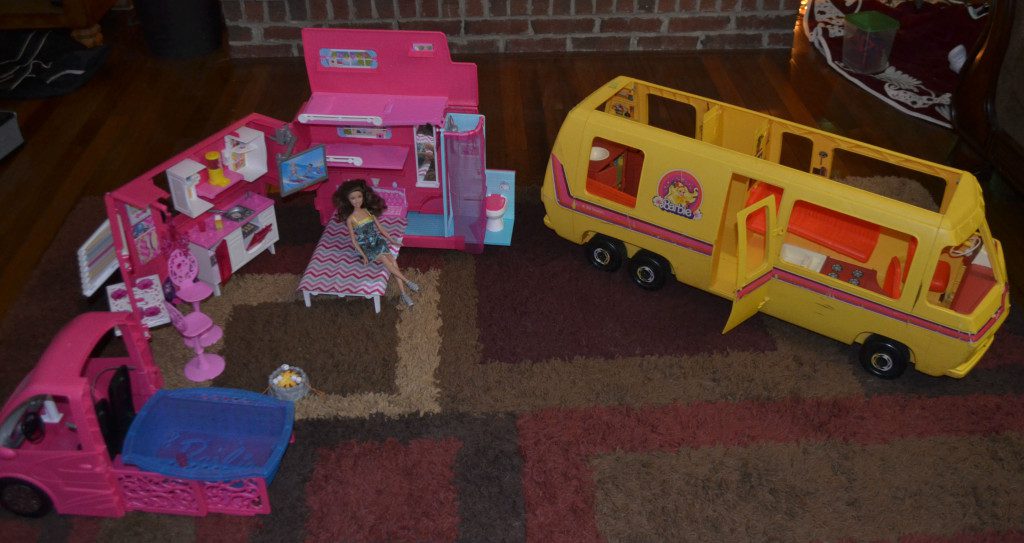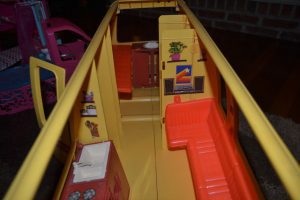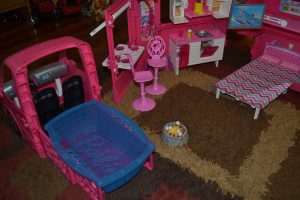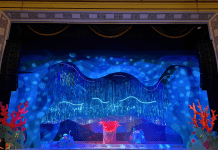
CMB’s Jesika Roy wrote a gender marketing piece a few weeks ago which resonated with me – as well as I’m sure with many moms who have been in the trenches fighting the battle of “boy toys” and “girl toys.” This is a topic we revisit at our house often. “There’s no such thing as ‘boy toys’ or ‘girl toys'” I wail to my kids. “Toys are just toys and are for everyone!”
 And this isn’t a Barbie-bashing post. I love Barbie. I might even be something of a Barbie apologist, which can be a difficult pill for a self-avowed feminist. But I played with Barbies and loved Barbies and you know, possibly I’m deluding myself but I don’t feel like I ever really thought I needed to aspire to measurements that would cause an actual human being to topple over or have displaced organs. I just played with my Barbies, and they had amazing, and sometimes probably super-weird or terrifying adventures.
And this isn’t a Barbie-bashing post. I love Barbie. I might even be something of a Barbie apologist, which can be a difficult pill for a self-avowed feminist. But I played with Barbies and loved Barbies and you know, possibly I’m deluding myself but I don’t feel like I ever really thought I needed to aspire to measurements that would cause an actual human being to topple over or have displaced organs. I just played with my Barbies, and they had amazing, and sometimes probably super-weird or terrifying adventures.
I had all of the Barbie accouterments. The Dream House. The Corvette. And, the Motorhome. So, I wasn’t unsympathetic when E said she wanted the 2014 version of a Barbie camper – the “Glam Camper”. In fact, I was on board. So I bought it. I assembled it in the grand tradition of all harried parents on Christmas Eve, and it wasn’t bad as those things go really. Mostly, a lot of stickers to place. E has been having fun with it. But, it struck me as I was ever-so-carefully aligning a cereal carton sticker on a tiny plastic box – the Glam Van is an upgrade in almost every way. It sleeps four and has a flat screen TV, juice maker, breakfast bar, fire pit, slide-out for the bathroom with shower (that is not actually tall enough for a Barbie, but whatever, logistics) and a somewhat inexplicable pool (hot tub?) that attaches to the front cab of the camper. But there’s one important (I think) way in which the 2014 Glam Van is noticeably inferior to the 1980 edition.
It. Is. So. Pink.
I mean the pink is pervasive, purposeful. And I’m not anti-pink (I concede it isn’t my favorite color, but I don’t dislike it either). But compared to the 1980’s version…
Pink pink pink pink pink PINK!
As it happens, I can compare the progress, or lack thereof, in gender neutrality apples to apples. I still have my circa 1980 Barbie motorhome. My parents saved it and it migrated from here to there to my dad’s attic, which was most decidedly not his preference. So he gave it back to me, and my kids have played with it since. It’s a bit dilapidated at this point, which might be why E was so hopeful about getting the new one. But there it sits, in all its late 1970’s – early ’80’s plasticine glory. Yellow. Kind of a Schoolhouse Rock yellow, if you ask me.


“Gender-coded toy advertisements . . . declined markedly in the early 1970s. By then, there were many more women in the labor force and, after the Baby Boom, marriage and fertility rates had dropped. In the wake of those demographic shifts and at the height of feminism’s second-wave, playing upon gender stereotypes to sell toys had become a risky strategy. In the Sears catalog ads from 1975, less than 2 percent of toys were explicitly marketed to either boys or girls. More importantly, there were many ads in the ‘70s that actively challenged gender stereotypes—boys were shown playing with domestic toys and girls were shown building and enacting stereotypically masculine roles . . . [But] the de-gendering trend in toys was short-lived. In 1984, the deregulation of children’s television programming suddenly freed toy companies to create program-length advertisements for their products, and gender became an increasingly important differentiator of these shows and the toys advertised alongside them. During the 1980s, gender-neutral advertising receded, and by 1995, gendered toys made up roughly half of the Sears catalog’s offerings—the same proportion as during the interwar years.”
















